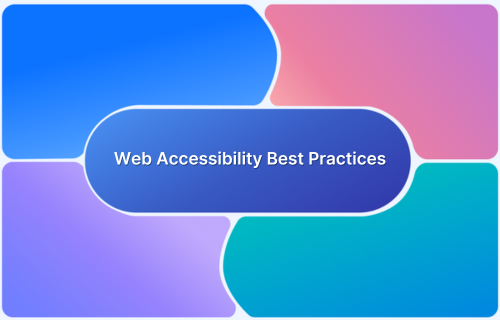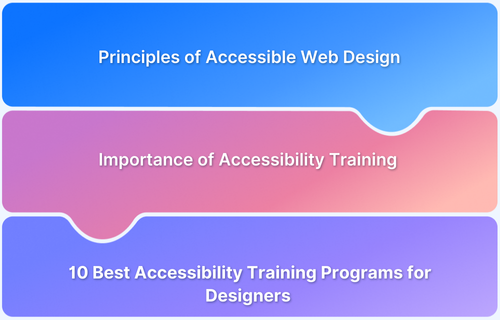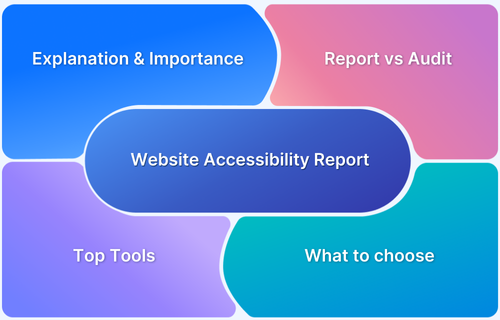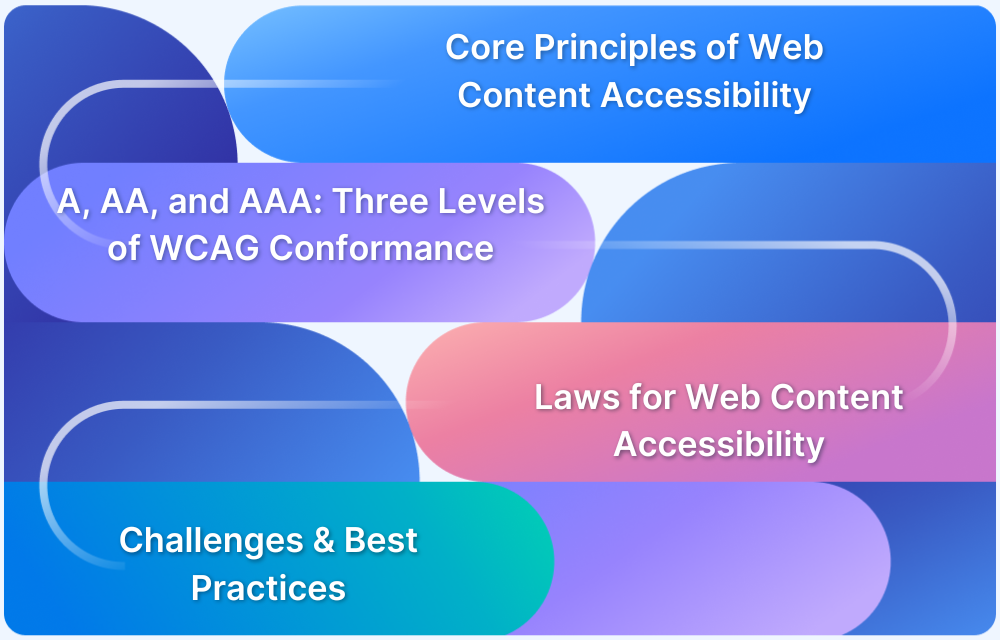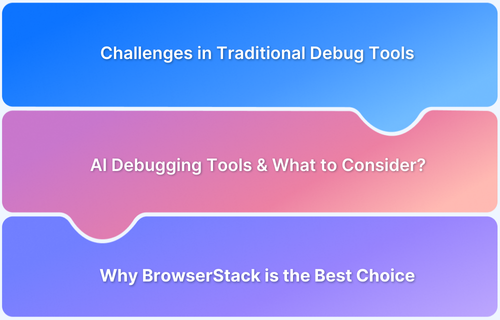Accessibility testing ensures digital products are usable for everyone, but manual checks often fall short. AI is transforming this process by making issue detection faster, smarter, and more reliable, paving the way for truly inclusive experiences.
Overview
AI in accessibility testing automates issue detection, minimizes manual effort, and delivers context-aware insights to enhance accuracy.
How AI Enhances Accessibility Testing:
- Automated Compliance Checks: AI can automatically assess whether a website or application meets accessibility standards like WCAG (Web Content Accessibility Guidelines).
- Faster Issue Detection: AI tools can quickly identify accessibility barriers such as missing alt text, color contrast issues, or navigability problems.
- Continuous Monitoring: AI tools can run regular checks, ensuring that accessibility is maintained during updates or changes to the application.
- Improved User Simulation: AI simulates user experiences with disabilities, helping testers identify issues that may not be visible to able-bodied users.
- Real-Time Feedback: Provides immediate, actionable feedback to developers, allowing for faster remediation of accessibility issues.
Key Applications of AI in Accessibility Testing:
- Automated Color Contrast Analysis: AI evaluates color schemes to ensure sufficient contrast for visually impaired users.
- Voice Command Testing: AI helps test and optimize voice command functionality for users with mobility or visual impairments.
- Screen Reader Compatibility: AI identifies how well an application interacts with screen readers and suggests improvements.
- Keyboard Navigation: AI simulates keyboard-only navigation to check if all interactive elements are accessible.
- Text-to-Speech and Speech Recognition: AI ensures that text-to-speech features work accurately and that speech recognition tools are properly integrated for users with limited mobility.
This article explores how AI is reshaping accessibility testing, highlighting its key benefits, limitations, and best practices for effective implementation.
Understanding Accessibility Testing
Accessibility testing ensures that digital products, websites, apps, and software, are usable by people of all abilities, including those with visual, auditory, cognitive, or motor impairments.
It focuses on validating whether a product meets accessibility standards such as WCAG (Web Content Accessibility Guidelines) and complies with regulations like ADA and the European Accessibility Act.
The goal goes beyond compliance, accessibility testing helps deliver inclusive experiences, enabling equal access to information, services, and interactions for every user. By identifying barriers early, teams can improve usability, enhance customer satisfaction, and expand their reach to a wider audience.
The Role of AI in Accessibility Testing
AI is revolutionizing accessibility testing by automating the detection of complex digital barriers that traditional methods often miss. It accelerates testing through intelligent audit automation, enabling rapid scans across vast web and app environments while providing context-aware insights.
By simulating real user interactions, including those with disabilities, AI uncovers nuanced accessibility issues, improving both accuracy and coverage.
Beyond detection, AI supports continuous learning and adaptation, evolving with dynamic user interfaces and emerging accessibility standards. This not only reduces manual effort but also empowers teams without deep accessibility expertise to deliver more inclusive digital experiences efficiently.
Combined with human oversight, AI transforms accessibility testing into a scalable, proactive process essential for meeting compliance and enhancing user experience.
BrowserStack Accessibility Testing enables teams to identify and fix accessibility gaps across web and mobile applications, ensuring compliance with global standards and delivering inclusive user experiences.
With its AI-powered Issue Detection Agent, BrowserStack accelerates accessibility testing by automatically detecting issues and providing actionable insights, helping teams ship accessible products faster and more confidently.
How AI Helps Enhances Accessibility Testing
AI enhances accessibility testing by going beyond rule-based checks and applying intelligent analysis to identify issues more effectively. It uses machine learning, natural language processing, and computer vision to evaluate digital products in ways that mimic real-world user interactions.
- Image recognition: Detects missing or inaccurate alt text by analyzing images and suggesting meaningful descriptions.
- Natural language processing (NLP): Reviews page structure, labels, and content readability to ensure clarity for assistive technologies.
- Pattern recognition: Identifies recurring accessibility issues across large applications, reducing duplication in testing.
- Context-aware detection: Distinguishes between critical accessibility barriers and minor layout shifts, reducing false positives.
- Simulation of user behaviors: Mimics interactions with screen readers, keyboards, and other assistive technologies to uncover usability gaps.
By combining these capabilities, AI enables teams to find issues earlier, improve accuracy, and create more inclusive digital experiences without relying solely on manual checks.
How to Use AI for Accessibility
Using AI for accessibility testing involves leveraging advanced tools and techniques to identify and resolve barriers that may hinder users with disabilities. Here’s how you can effectively use AI for accessibility:
- Integrate AI-Driven Accessibility Tools: Use AI-powered accessibility testing tools that automatically detect common accessibility issues such as missing alt text, improper heading structure, or low color contrast.
- Run Automated Scans: Regularly run AI-based scans on your website or application to ensure continuous accessibility compliance. These scans can identify issues quickly and provide detailed reports on how to fix them.
- Simulate User Experiences: Utilize AI to simulate how users with different disabilities (visual, hearing, or motor impairments) interact with your application. This helps you identify pain points that might not be obvious during manual testing.
- Leverage AI for Voice and Gesture Controls: Use AI to optimize voice-activated and gesture-based controls, ensuring that users with limited mobility can navigate the application seamlessly.
- Enhance Screen Reader Compatibility: AI tools can analyze the application’s content and layout, making sure that all interactive elements are compatible with screen readers, providing accurate feedback to users with visual impairments.
- Monitor and Improve Color Contrast: AI tools can automatically analyze the color contrast of your UI elements, ensuring that text is readable for users with color blindness or low vision.
- Provide Real-Time Feedback for Developers: AI tools give developers instant feedback on accessibility issues, allowing them to make real-time improvements and ensure the application remains fully accessible after updates.
Key Benefits of AI in Accessibility Testing
AI enhances accessibility testing by moving beyond rule-based checks and enabling smarter, faster, and more reliable evaluations. Instead of spending hours on repetitive audits, teams can focus on fixing meaningful issues and improving user experience.
The major benefits include:
- Speed and efficiency: AI accelerates testing by automatically detecting accessibility issues that would take much longer to uncover manually.
- Greater accuracy: Intelligent, context-aware detection reduces false positives and pinpoints real accessibility barriers.
- Scalability at every stage: From small applications to large enterprise systems, AI can run accessibility checks consistently across platforms and devices.
- Shift-left testing: Developers get real-time feedback during development, allowing issues to be resolved before they become costly.
- Stronger compliance alignment: AI helps teams meet global standards such as WCAG, ADA, and the European Accessibility Act with greater confidence.
- Improved inclusivity: Early detection and resolution of issues ensures smoother, more accessible experiences for all users.
Read More: What is Universal Design Accessibility?
Best Practices for Implementing AI in Accessibility Testing
While AI brings speed and intelligence to accessibility testing, it works best when combined with thoughtful practices that balance automation with human expertise.
Recommended best practices include:
- Combine AI with manual reviews: AI can quickly detect issues, but human testers ensure context, usability, and real-world accuracy.
- Engage people with disabilities: Involving real users provides insights that neither AI nor manual audits alone can deliver.
- Integrate testing early: Adopt a shift-left approach, using AI-driven feedback during development rather than waiting until release.
- Continuously validate AI outputs: Regularly review results to minimize false positives or overlooked issues.
- Stay updated with standards: Ensure testing aligns with evolving guidelines such as WCAG updates and the European Accessibility Act.
- Promote a culture of inclusivity: Use AI not just as a compliance tool, but as part of a broader commitment to accessible design.
Streamline Accessibility Testing with BrowserStack Issue Detection Agent
BrowserStack Accessibility Testing helps teams build inclusive digital experiences by identifying and fixing accessibility gaps across websites and mobile applications. It enables seamless compliance with global standards like WCAG and ADA, while ensuring every user can interact with products without barriers.
At the core of this solution is the AI-powered Issue Detection Agent, designed to make accessibility testing smarter and faster. Instead of overwhelming teams with pixel-level noise or irrelevant flags, the agent highlights meaningful accessibility issues and provides actionable insights.
This reduces false positives, accelerates reviews, and allows developers to focus on fixes that truly impact user experience.
By integrating directly into existing workflows, the Issue Detection Agent empowers teams to:
- Detect accessibility issues in real time.
- Prioritize critical problems with clear, AI-driven context.
- Reduce manual effort and testing overhead.
- Deliver inclusive, compliant digital experiences.
With BrowserStack, accessibility testing moves beyond compliance checks, it becomes a streamlined, intelligent process that helps teams ship accessible products faster.
Conclusion
AI is transforming accessibility testing by making it faster, smarter, and more reliable. While human expertise remains essential, AI ensures broader coverage and early detection of issues, helping teams build more inclusive digital products.
With solutions like BrowserStack’s AI-powered Issue Detection Agent, organizations can streamline their testing process, reduce false positives, and deliver accessible experiences that meet global standards with confidence.



